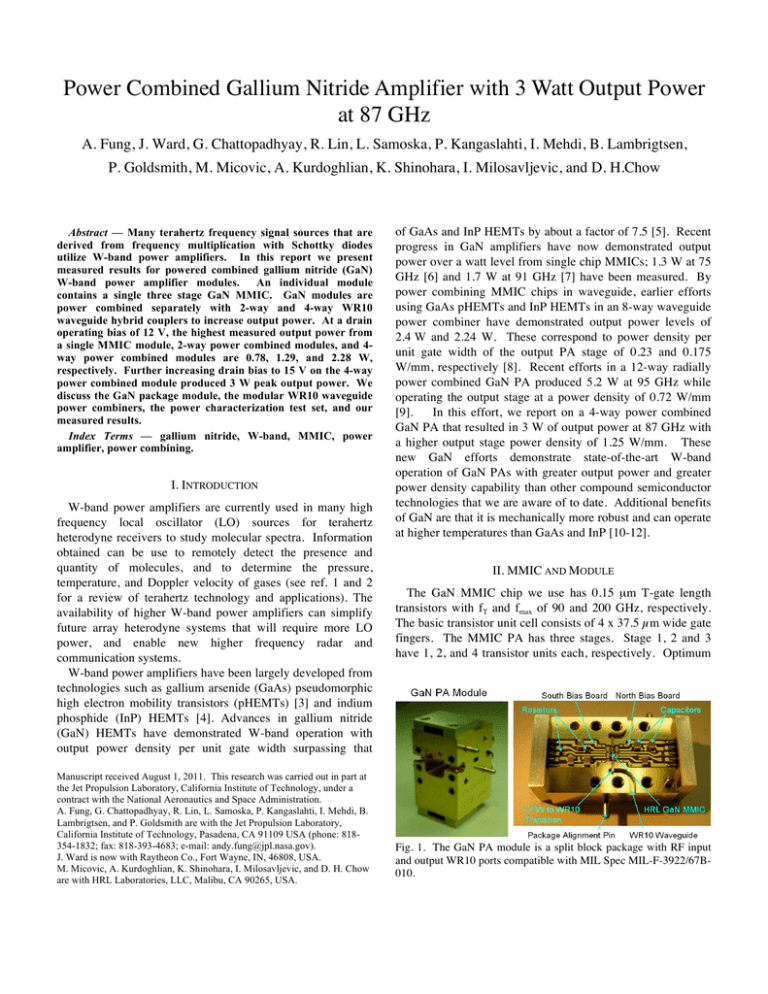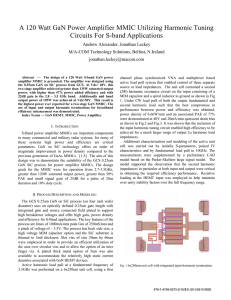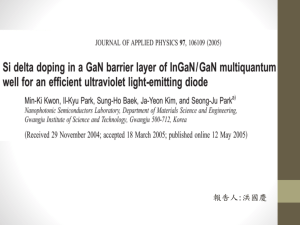
Power Combined Gallium Nitride Amplifier with 3 Watt Output Power
at 87 GHz
A. Fung, J. Ward, G. Chattopadhyay, R. Lin, L. Samoska, P. Kangaslahti, I. Mehdi, B. Lambrigtsen,
P. Goldsmith, M. Micovic, A. Kurdoghlian, K. Shinohara, I. Milosavljevic, and D. H.Chow
Abstract — Many terahertz frequency signal sources that are
derived from frequency multiplication with Schottky diodes
utilize W-band power amplifiers. In this report we present
measured results for powered combined gallium nitride (GaN)
W-band power amplifier modules.
An individual module
contains a single three stage GaN MMIC. GaN modules are
power combined separately with 2-way and 4-way WR10
waveguide hybrid couplers to increase output power. At a drain
operating bias of 12 V, the highest measured output power from
a single MMIC module, 2-way power combined modules, and 4way power combined modules are 0.78, 1.29, and 2.28 W,
respectively. Further increasing drain bias to 15 V on the 4-way
power combined module produced 3 W peak output power. We
discuss the GaN package module, the modular WR10 waveguide
power combiners, the power characterization test set, and our
measured results.
Index Terms — gallium nitride, W-band, MMIC, power
amplifier, power combining.
I. INTRODUCTION
W-band power amplifiers are currently used in many high
frequency local oscillator (LO) sources for terahertz
heterodyne receivers to study molecular spectra. Information
obtained can be use to remotely detect the presence and
quantity of molecules, and to determine the pressure,
temperature, and Doppler velocity of gases (see ref. 1 and 2
for a review of terahertz technology and applications). The
availability of higher W-band power amplifiers can simplify
future array heterodyne systems that will require more LO
power, and enable new higher frequency radar and
communication systems.
W-band power amplifiers have been largely developed from
technologies such as gallium arsenide (GaAs) pseudomorphic
high electron mobility transistors (pHEMTs) [3] and indium
phosphide (InP) HEMTs [4]. Advances in gallium nitride
(GaN) HEMTs have demonstrated W-band operation with
output power density per unit gate width surpassing that
Manuscript received August 1, 2011. This research was carried out in part at
the Jet Propulsion Laboratory, California Institute of Technology, under a
contract with the National Aeronautics and Space Administration.
A. Fung, G. Chattopadhyay, R. Lin, L. Samoska, P. Kangaslahti, I. Mehdi, B.
Lambrigtsen, and P. Goldsmith are with the Jet Propulsion Laboratory,
California Institute of Technology, Pasadena, CA 91109 USA (phone: 818354-1832; fax: 818-393-4683; e-mail: andy.fung@jpl.nasa.gov).
J. Ward is now with Raytheon Co., Fort Wayne, IN, 46808, USA.
M. Micovic, A. Kurdoghlian, K. Shinohara, I. Milosavljevic, and D. H. Chow
are with HRL Laboratories, LLC, Malibu, CA 90265, USA.
of GaAs and InP HEMTs by about a factor of 7.5 [5]. Recent
progress in GaN amplifiers have now demonstrated output
power over a watt level from single chip MMICs; 1.3 W at 75
GHz [6] and 1.7 W at 91 GHz [7] have been measured. By
power combining MMIC chips in waveguide, earlier efforts
using GaAs pHEMTs and InP HEMTs in an 8-way waveguide
power combiner have demonstrated output power levels of
2.4 W and 2.24 W. These correspond to power density per
unit gate width of the output PA stage of 0.23 and 0.175
W/mm, respectively [8]. Recent efforts in a 12-way radially
power combined GaN PA produced 5.2 W at 95 GHz while
operating the output stage at a power density of 0.72 W/mm
[9].
In this effort, we report on a 4-way power combined
GaN PA that resulted in 3 W of output power at 87 GHz with
a higher output stage power density of 1.25 W/mm. These
new GaN efforts demonstrate state-of-the-art W-band
operation of GaN PAs with greater output power and greater
power density capability than other compound semiconductor
technologies that we are aware of to date. Additional benefits
of GaN are that it is mechanically more robust and can operate
at higher temperatures than GaAs and InP [10-12].
II. MMIC AND MODULE
The GaN MMIC chip we use has 0.15 µm T-gate length
transistors with fT and fmax of 90 and 200 GHz, respectively.
The basic transistor unit cell consists of 4 x 37.5 µm wide gate
fingers. The MMIC PA has three stages. Stage 1, 2 and 3
have 1, 2, and 4 transistor units each, respectively. Optimum
Fig. 1. The GaN PA module is a split block package with RF input
and output WR10 ports compatible with MIL Spec MIL-F-3922/67B010.
gain 50 ohm inter-stage matching is used to minimize
potential issues from uncertainties in the transistor model.
The net output stage gate periphery is 600 µm. The MMIC
PA was designed and fabricated by HRL Laboratories under
HRL internal research and development efforts [13]. The
single chip GaN PA MMIC is packaged in a split block Wband amplifier module. The module has two separate bias
boards for the drain (north side) and gate (south side) bias
lines of the MMIC. Figure 1 shows the general layout of the
package. The GaN MMIC chip resides in a cavity in which
waveguide modes are ideally cut off. Off-chip bias line
capacitors and resistors are added near the MMIC and on the
DC bias boards for decoupling. The bias boards are fitted
with a socket receptacle for easy connection to voltage bias
supplies. For transmitting RF signal from the MMIC to the
input and output WR10 waveguides of the module, microstrip
to waveguide transitions are used. Wirebonds complete all
chip to RF transitions and DC bias board connections.
(a)
III. WAVEGUIDE HYBRID COUPLER POWER COMBINERS
The 2- and 4-way power combiners (splitters) examined in
this study utilize waveguide hybrids [14] and are designed to
function over the full W-Band. A waveguide hybrid is a fourport directional coupler. Ideally, power incident on any port is
divided equally between two other ports with a 90° phase
difference, and the fourth port is isolated. The waveguide form
of quadrature hybrid consists of two parallel waveguides
coupled through a series of apertures or branch waveguides.
The number of waveguide branches determines the fractional
bandwidth of the coupler. Hybrid couplers used as power
splitters and combiners have an advantage over traditional
waveguide Y-splitters in that the hybrid couplers are balanced
and offer better return loss.
In the 2- and 4-way waveguide hybrid coupler power
combiners (splitters), 6-branch couplers allow for full W-band
(75-110 GHz) operation. The designs are optimized using a 3D electromagnetic simulator (Ansoft’s High Frequency
Structure Simulator – HFSS) and Agilent’s linear circuit
simulator (Advanced Design System – ADS) using an
iterative technique known as space mapping [15]. The
parameters that are optimized in the two hybrid coupler
designs are the amplitude and phase imbalance at the output
ports and the return loss performance at all the ports. We
designed the couplers to have less than ±0.5 dB of amplitude
imbalance and 90°±1° phase shift over the entire W-band.
Figure 2 shows the schematic of the 4-way hybrid coupler
power combiner and measured S-parameters of both the 2and 4-way combiners measured back-to-back in pairs. For the
2 to 1 hybrid coupler combiner measured back-to-back,
insertion loss is less than 1.2 dB and return loss is greater than
16.4 dB across the band. For the 4 to 1 hybrid coupler
combiner measured back-to-back, insertion loss is less than
2.5 dB and return loss is greater than 17.5 dB.
IV. POWER PERFORMANCE MEASUREMENTS
(b)
(c)
Fig. 2. Characteristics of the 2- and 4-way power combiners
(splitters). (a) Diagram of the 4 to 1 port power combiner (splitter).
Internal ports are terminated by matched absorber loads. The 2 to 1
port power combiner (not shown) is a special case of the 4 to 1 port
design. (b) S-Parameters of the back-to-back 2 to 1 port combiners.
(c) S-Parameters of the back-to-back 4 to 1 port combiners.
The power-in versus power-out (PiPo) characterization test
set consists of a frequency multiplied signal source. An
Agilent 20 GHz signal synthesizer is used as the initial signal
generator. A Millitech sextupler is used to multiply the
synthesizer signal to W-band frequency. Different custom JPL
packaged PAs are used to provide adequate input test power at
various W-band frequencies. A variable attenuator is used to
change the test signal power level. An isolator is used to
improve matching for the test PA output and the GaN PA
device under test (DUT) input. Couplers allow for the input
and output test signal power levels to and from the DUT to be
sampled. An Agilent W-band and an Erickson broadband
power meter monitor the input and output power levels of the
DUT. A high power load terminates the output of the test set.
Output power as a function of frequency has been measured
at various input power levels for the 2- and 4-way power
combined GaN PAs that are constructed from multiple units of
the single chip module. The power combined PA’s saturated
output power increases while the unsaturated gain remains
essentially the same as a single amplifier module except for
slight losses due to non-ideal amplitude and phase combining,
and passive losses in the combiner waveguides themselves.
The 2- and 4-way power combined GaN PAs are shown in
Figures 3 (a) and 4 (a). Operating at 12 V drain bias, for the
2- and 4-way power combined GaN PAs respectively, the
maximum output powers are 1.29 and 2.28 W; corresponding
gains are 8.1 and 6.7 dB; and power added efficiencies (PAEs)
are 13.7 and 11.2 %. The maximum output power achieved in
this study is 3 W with 6.6 dB gain and 10.2 % PAE at 15 V
drain bias with the 4-way GaN PA (see Fig. 4 (c)).
(a)
(b)
(a)
(c)
(b)
Fig. 4. 4-way waveguide power combined GaN PA results. (a) Photo
of the power combined GaN PA. Individual amplifier modules are
staggered with waveguide sections to prevent mechanical
interference and are not intended to add any net phase shifts at the
input of the power combiners. (b) Output power measured at input
power levels of 10, 20 and 25 dBm as a function of frequency. (c)
PiPo, gain and PAE of the 4-way power combined PA at 87 GHz.
V. THREE MONTH POWER-ON TEST
(c)
Fig. 3. 2-way waveguide power combined GaN PA results. (a) Photo
of the power combined GaN PA. (b) Output power measured at
input power levels of 0, 10, 15, 20 and 23 dBm as a function of
frequency. (c) PiPo, gain and PAE of the 2-way power combined PA
at 87 GHz.
We examined the characteristics of a single MMIC chip
module under continuous input power at ambient temperature.
The amplifier was DC biased where the gain S21 is
approximately optimized, peaking slightly at 86 GHz.
For
the extended time power-on response test, the amplifier is
driven into compression with 22 dBm at 86 GHz. During the
test, output power, input power, and the bias conditions of
each of the three stages of the MMIC amplifier are recorded
(see Fig. 5). Measurements indicate there is a settling time for
the output power of the amplifier to reach a steady value from
the initial power on value. The packaged amplifier MMIC
was not subjected to a burn-in period prior to the test. Output
power and also PAE show some fluctuations that coincide in
time with drain current bias fluctuation changes. The cause of
the drain current bias fluctuations is still under
(a)
investigation. Gate current of the middle stage of the
amplifier increases in magnitude while the input and output
stages remain essentially constant during the three-month test.
The output power level doesn’t appear to be greatly affected
by the measured bias changes and remains fairly constant after
the initial settling period. The test data we present here is our
first examination of extended power-on performance of one
amplifier module. More effort in accelerated lifetime testing
at elevated temperatures with additional test samples would
benefit determination of mean time to failure (see ref. [10] for
more discussions).
VI. CONCLUSION
(b)
We report results on waveguide power combined GaN
MMIC modules for W-band operation. By power combining
four GaN modules with waveguide hybrid couplers, a
maximum output power of 3 W, with 6.6 dB gain and 10.2 %
PAE was measured. An extended power on-test of three
months duration was performed on a single MMIC chip
module. After an initial settling period of the output power
level and drain currents, the output power remained essentially
constant. It is expect future W-band PAs will migrate towards
GaN based semiconductors from other III-V compound
semiconductors as the technology matures in terms of
reliability and cost.
ACKNOWLEDGMENT
The authors thank Mary Soria, Joelle Cooperrider, and Peter
Bruneau of JPL, and Dr. William Jeffrey and Dr. Conilee
Kirkpatrick of HRL for their support.
(c)
(d)
Fig. 5. Extended time power-on test results for a packaged single
MMIC chip module. (a) Plot of output power, input power, PAE and
gain versus time. (b) Plot of drain current of each of the three stages
of the MMIC amplifier versus time. (c) Plot of gate current of each
of the three stages of the MMIC amplifier versus time. (d) Plot of
drain and gate voltage supply values versus time.
REFERENCES
[1] P. H. Siegel, “Terahertz Technology,” IEEE Trans. Microwave
Theory & Tech., vol. 50, no. 3, pp. 910-928, March 2002.
[2] P. H. Siegel, “THz Instruments for Space,” IEEE Trans.
Antennas Propagat., vol. 55, no. 11, Part 1, pp. 2957-2965,
November 2007.
[3] H. Wang, L. Samoska, T. Gaier, A. Peralta, H. Liao, Y. C.
Leong, S. Weinreb, Y. C. Chen, M. Nishimoto, and R. Lai,
“Power-amplifier modules covering 70-113 GHz using
MMICs,” IEEE Trans. Microwave Theory & Tech., vol. 49, no.
1, pp. 9-16, January 2001.
[4] Y. C. Chen, D. L. Ingram, R. Lai, M. Barsky, R. Grunbacher, T.
Block, H. C. Yen, and D. C. Streit, “A 95-GHz InP HEMT
MMIC amplifier with 427-mW power output,” IEEE Microwave
Guided Wave Lett., vol. 8, no. 11, pp. 399-401, November 1998.
[5] M. Micovic, A. Kurdoghlian, H. P. Moyer, P. Hashimoto, M.
Hu, M. Antcliffe, P. J. Willadsen, W. S. Wong, R. Bowen, I.
Milosavljevic, Y. Yoon, A. Schmitz, M. Wetzel, C. McGuire, B.
Hughes, and D. H. Chow, “GaN MMIC PAs for E-Band (71
GHz – 95 GHz) Radio,” IEEE Compound Semi. IC Symp. Dig.,
pp. 1-4, October 2008.
[6] Y. Nakasha, S. Masuda, K. Makiyama, T. Ohki, M. Kanamura,
N. Okamoto, T. Tajima, T. Seino, H. S., K. Imanishi, T.
Kikkawa, K. Joshin, and Naoki Hara, “E-Band 85-mW
Oscillator and 1.3-W Amplifier IC’s using 0.12-mm GaN
HEMTs for Millimeter-wave Transceivers,” IEEE Compound
Semi. IC Symp. Dig., October 2010.
[7] A. Brown, K. Brown, J. Chen, K. C. Hwang, N. Kolias, and R.
Scott, “W-band GaN Power Amplifier MMICs,” IEEE MTT-S
International Microwave Symposium Dig., vol. , pp. -, June
2011.
[8] D. L. Ingram, Y. C. Chen, I. Stones, D. Yamauchi, B. Brunner,
P. Huang, M. Biedenbender, J. Elliot, R. Lai, D. C. Streit, K. F.
Lau, and H. C. Yen, “Compact W-Band Solid-State MMIC
High Power Sources,” IEEE MTT-S International Microwave
Symposium Dig., vol. 2, pp. 955-958, June 2000.
[9] J. Schellenberg, E. Watkins, M Micovic, B. Kim, and K. Han,
“W-Band, 5W Solid-State Power Amplifier/Combiner,” IEEE
MTT-S International Microwave Symposium Digest, May 2010.
[10] U. K. Mishra, L. Shen, T. E. Kazior, Y.-F. Wu, “GaN-Based RF
Power Devices and Amplifiers,” Proceedings of the IEEE, vol.
96, no. 2, pp. 287-305, February 2008.
[11] D. Maier, M. Alomari, N. Grandjean, J-F Carlin, M-A DifortePoisson, C. Duan, A. Chuvilin, D.Troadec, C. Gaquiere, U.
Kaiser, S. Delage, E. Kohn, “Above 500oC Operation of
Copyright 2011. All rights reserved.
InAlN/GaN HEMTs,” IEEE Int. Electron Device Meeting. Dig.,
December 2009.
[12] F. Medjdoub, J-F Carlin, M. Gonschorek, E. Feltin, M.A. Py,
D. Ducatteau, C. Gaquiere, N. Grandjean, E. Kohn, "Can
InAlN/GaN be an alternative to high power / high temperature
AlGaN/GaN devices?" IEEE Int. Electron Device Meeting. Dig.,
vol., no., pp.1-4, 11-13 Dec. 2006.
[13] M. Micovic, A. Kurdogklian, K. Shinohara, S. Burnham, I.
Milosavljevic, A. Corrion, M. Hu, W.S. Wong, A. Schmitz, P.
Hashimoto, P. J. Willadsen, D. H. Chow, A. Fung, R. Lin, L.
Samoska, P. Kangaslahti, B. Lambrigsten, and P. Goldsmith,
“W-Band GaN MMIC with 842mW Output Power at 88 GHz,”
IEEE MTT-S International Microwave Symposium Digest, May
2010.
[14] S. Srikanth and A. R. Kerr, “Waveguide Quadrature Hybrids for
ALMA Receivers,” ALMA Memo 343, January 2001.
[15] J. W. Bandler, R. M. Biernacki, S. H. Chen, and Y. F. Huang,
“Design Optimization of Interdigital Filters Using Aggressive
Space Mapping and Decomposition,” IEEE Trans. Microwave
Theory & Tech., vol. 49, no. 5, pp. 761-769, May 1997.

![Structural and electronic properties of GaN [001] nanowires by using](http://s3.studylib.net/store/data/007592263_2-097e6f635887ae5b303613d8f900ab21-300x300.png)



